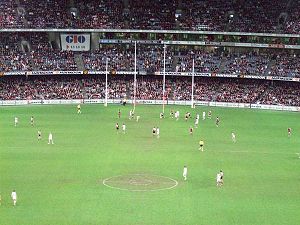History of the Australian Football League
In 1908, the league expanded to ten teams, with Richmond crossing from the VFA, and University from the Metropolitan Football Association.
University, after three promising seasons, finished last each year from 1911 until 1914, including losing an unprecedented 51 matches in a row; this was in part caused by its players' focus on their studies rather than football, particularly during examinations, and it was partly because the club operated on an amateur basis at a time when player payments were becoming common—and, as a result, the club withdrew from the VFL at the end of 1914.
In 1925, the VFL expanded from nine teams to twelve, with Footscray, Hawthorn and North Melbourne each crossing from the VFA.
Melbourne, which had won the Premiership in 1926 but fallen off sharply, developed a powerful attacking side that swept all before it between 1939 and 1941 to win three successive flags.
The VFL played the first of a series of exhibition matches in 1962 in an effort to lift the international profile of the league.
Country zoning was introduced in the late 1960s, and whilst it pushed Essendon and Geelong from the top of the ladder, it created severe inequality during the 1970s and 1980s.
Construction work was carried out at the stadium as the 1970s progressed, culminating in the building of the now-heritage-listed Sir Kenneth Luke stand.
The 1970 grand final between traditional rivals Carlton and Collingwood, arguably the league's most famous game of all time, saw Carlton recover from a 44-point deficit at half-time to win the game by ten points; it featured a famous spectacular mark by Alex Jesaulenko, and it was witnessed by a record crowd of 121,696.
As a result of this, rising cost pressures were driving some of Victoria's weaker clubs into dire financial situations.
These expansion team licenses were awarded on payment of multimillion-dollar fees which were not required of the existing VFL clubs.
In the late 1980s, the former zoning arrangements which had led to such inequality between the stronger and weaker clubs began to be phased out.
The 1989 Grand Final between Hawthorn and Geelong is considered one of the finest and most violent grand finals, with many strong physical encounters, brutal injuries, heroic feats of near-fatal courage by Dermott Brereton and Robert DiPierdomenico, a joint grand final record nine goals by Geelong's Gary Ablett Sr., and Geelong coming back from a 36-point deficit at three-quarter time—only to fall six points short of victory.
Functionally, the AFL gave up control over its Victorian-based minor grades at the end of 1991—clubs continued to field reserves teams in the independent Victorian State Football League, while an entirely new under-18s competition (the TAC Cup) was established with new, zone-based clubs.
In response, the SANFL established a composite South Australian team called the Adelaide Crows, which was awarded the licence instead and joined the league in 1991 as the fourth interstate club.
In 1996, the VFL/AFL celebrated its centenary; the Australian Football Hall of Fame was established and the VFL/AFL Team of the Century was named.
With the Brisbane–Fitzroy merger opening up a free slot for a 16th team, Port Adelaide was awarded an AFL licence, and they joined the league in 1997.
Through the 1990s, there was a significant trend of Melbourne-based teams abandoning the use of their small (20,000–30,000 capacity) suburban venues for home matches in favour of the larger MCG and Waverley Park.
The 2002 season saw the Carlton Football Club finish last, becoming the last of the twelve VFL clubs to win its first wooden spoon, before being heavily penalised for cheating the salary cap a few years earlier; the penalties saw Carlton stay near the bottom of the ladder in most of the subsequent seasons.
A series of new rule changes were introduced for the 2006 season, intended to speed up the game, including allowing full-backs to kick in more quickly after a behind, and limiting the length of time that a player was allowed to hold the ball after a mark to 8 seconds for a mark in general play, and 30 seconds for a set shot.
Several teams established a regular presence in other parts of Australasia during the 21st century, generally by playing between one and four home matches in the alternative location.
In the late 2000s, the AFL looked to establish a permanent presence on the Gold Coast, which was fast-developing as a major population centre.
In 2015, tragedy struck when Adelaide coach Phil Walsh was murdered mid-season, causing an outpouring of grief and the first-ever AFL game cancellation.
In 2016, the Western Bulldogs, plagued by injuries, finished the regular season in seventh place, the second-lowest team to qualify for finals.
And in 2017, the Richmond Tigers won the flag after a miraculous season and a surprising win over minor premiers Adelaide Crows.
Richmond won their first in 37 years and broke a record for biggest comeback season after finishing 13th in 2016; additionally, Richmond's Dustin Martin became the first player in VFL/AFL history to win a Brownlow Medal, a Norm Smith Medal, and a premiership medallion in the same year.
The 2018 season ended bitterly for Collingwood, losing to the West Coast Eagles by five points in the 2018 grand final.
In addition to putting the health of players, staff, and spectators in jeopardy, the 2020 AFL season needed to be majorly restructured to accommodate unprecedented challenges.
Like many professional sports leagues, the AFL sustained heavy operating losses during the first couple years as it scrambled to mitigate the financial damage of the pandemic.
[10] The AFL maintained a strict vaccination requirement and implemented a generous top-up list to compensate for self-isolating players.
The 2022 grand final eclipsed 100,000 spectators for the first time since 2019 and was won by Geelong, who defeated Sydney by a margin of 81 points.


